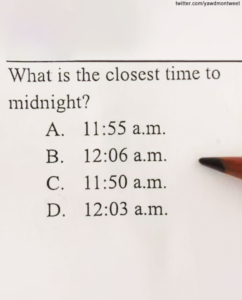Math Question for Kids Sparked Heated Debate – People Can’t Agree on the Right Answer
What was supposed to be a simple math question for children has recently turned into a viral internet sensation, sparking a fiery debate among adults across social media. The problem, which appeared on a worksheet intended for elementary school students, has left thousands scratching their heads—and arguing in the comments.
The question seems simple at first glance. It goes something like this:
“What is 8 ÷ 2(2 + 2)?”
While this may seem like a straightforward problem, it has divided people into two major camps—those who believe the answer is 16 and those who are convinced it’s 1. Both sides are confident they’re correct, but the disagreement highlights a deeper issue about how math is taught and interpreted today.
Here’s a breakdown of the two main approaches:
The “16” Answer
People who say the answer is 16 follow the standard order of operations, often remembered by the acronym PEMDAS (Parentheses, Exponents, Multiplication and Division [from left to right], Addition and Subtraction [from left to right]).
Step-by-step:
-
Solve the parentheses first: (2 + 2) = 4
-
Rewrite the equation: 8 ÷ 2 × 4
-
Now go from left to right: 8 ÷ 2 = 4, then 4 × 4 = 16
The “1” Answer
Those who argue for 1 interpret the expression differently. They treat the “2(2 + 2)” part as a single grouped multiplication due to the lack of a multiplication sign and see it as implying that 2 should multiply the entire (2 + 2) group first.
Step-by-step:
-
Solve the parentheses: (2 + 2) = 4
-
Then treat it as: 8 ÷ [2 × 4] = 8 ÷ 8 = 1
The confusion arises from the ambiguity in how the expression is written. In professional math, equations are often written more clearly with added parentheses or division symbols to prevent this exact misunderstanding. But in casual or educational settings, shorthand like this is common—and risky.
So Who’s Right?
Technically, both answers are understandable depending on how the expression is interpreted. However, according to most modern math conventions that follow strict left-to-right processing for multiplication and division, 16 is considered the more “correct” answer. But the fact that so many people arrived at 1 highlights a real issue in how expressions are taught and how they can be misread.
The Internet Reacts
On platforms like Twitter, Reddit, and TikTok, the debate raged. People shared screenshots of the question, polled their followers, and even created videos trying to prove their logic. Some users were shocked that something taught in grade school could still confuse adults. Others joked, “This is why I became an artist.”
Regardless of the “right” answer, the viral question has served as a reminder that clarity in communication—even in math—is everything. For now, the internet remains divided, and a kid’s math problem has proven just how complex “simple” can really be.
